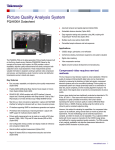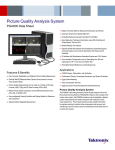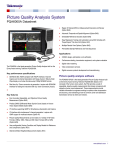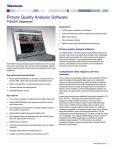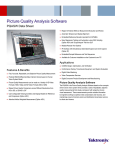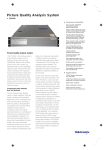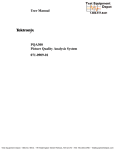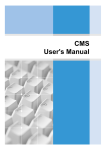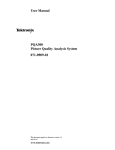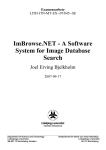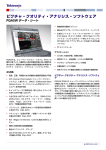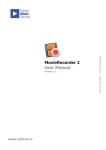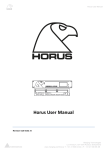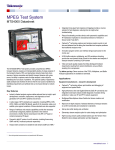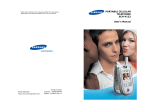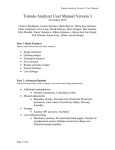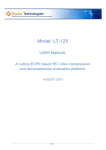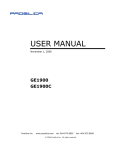Download PQA600A Picture Quality Analysis System Datasheet
Transcript
Picture Quality Analysis System PQA600A Datasheet Region Of Interest (ROI) on Measurement Execution and Review (Option BAS) Automatic Temporal and Spatial Alignment (Option BAS) Embedded Reference Decoder (Option BAS) Easy Regression Testing and Automation using XML Scripting with "Export/Import" File from GUI (Option ADV) Multiple Results View Options (Option BAS) Preinstalled Sample Reference and Test Sequences Applications CODEC Design, Optimization, and Verification Features & Benefits Fast, Accurate, Repeatable, and Objective Picture Quality Measurement (Option BAS) Predicts DMOS (Differential Mean Opinion Score) based on Human Vision System Model (Option BAS) SD/HD/3G SDI, HDMI compliant with HDCP interface and IP interface supporting IGMP for Simultaneous Generation and Capture, 2-channel Capture and 2-channel Generation with Swap-channel / Side by Side / Wipe display Real time Up / Down conversion at generation / capture with SDI/HDMI interface for testing the instrument with Up / down conversion process. IP Interface with simultaneous 2–channel generation / capture with IGMP support for multicast streams (Option IP) Picture Quality Measurements can be made on a Variety of HD Video Formats (1080p, 1080i, 720p) and SD Video Formats (525i or 625i) (Option BAS) User-configurable Viewing Condition and Display Models for Reference and Comparison (Option ADV) Attention/Artifact Weighted Measurement (Option ADV) Conformance Testing, Transmission Equipment, and System Evaluation Digital Video Mastering Video Compression Services Digital Consumer Product Development and Manufacturing Picture Quality Analysis System The PQA600A is the latest-generation Picture Quality Analyzer built on the Emmy Award winning Tektronix PQA200/300. Based on the concepts of the human vision system, the PQA600A provides a suite of repeatable, objective quality measurements that closely correspond with subjective human visual assessment. These measurements provide valuable information to engineers working to optimize video compression and recovery, and maintaining a level of common carrier and distribution transmission service to clients and viewers. Datasheet User Interface of PQA600A. Showing reference, test sequences, with difference map and statistical graph. Compressed Video Requires New Test Methods The true measure of any television system is viewer satisfaction. While the quality of analog and full-bandwidth digital video can be characterized indirectly by measuring the distortions of static test signals, compressed television systems pose a far more difficult challenge. Picture quality in a compressed system can change dynamically based on a combination of data rate, picture complexity, and the encoding algorithm employed. The static nature of test signals does not provide true characterization of picture quality. 2 www.tektronix.com Human viewer testing has been traditionally conducted as described in ITU-R Rec. BT.500-11. A test scene with natural content and motion is displayed in a tightly controlled environment, with human viewers expressing their opinion of picture quality to create a Differential Mean Opinion Score, or DMOS. Extensive testing using this method can be refined to yield a consistent subjective rating. However, this method of evaluating the capabilities of a compressed video system can be inefficient, taking several weeks to months to perform the experiments. This test methodology can be extremely expensive to complete, and often the results are not repeatable. Thus, subjective DMOS testing with human viewers is impractical for the CODEC design phase, and inefficient for ongoing operational quality evaluation. The PQA600A provides a fast, practical, repeatable, and objective measurement alternative to subjective DMOS evaluation of picture quality. System Evaluation The PQA600A can be used for installation, verification, and troubleshooting of each block of the video system because it is video technology agnostic: any visible differences between video input and output from processing components in the system chain can be quantified and assessed for video quality degradation. Not only can CODEC technologies be assessed in a system, but any process that has potential for visible differences can also be assessed. For example, digital transmission errors, format conversion (i.e. 1080i to 480p in set-top box conversions), analog transmission degradation, data errors, slow display response times, frame rate reduction (for mobile transmission and videophone teleconferencing), and more can all be evaluated. Picture Quality Analysis System — PQA600A How It Works The PQA600A takes two video files as inputs: a reference video sequence and a compressed, impaired, or processed version of the reference. First, the PQA600A performs a spatial and temporal alignment between the two sequences, without the need for a calibration stripe embedded within the video sequence. Then the PQA600A analyzes the quality of the test video, using measurements based on the human vision system and attention models, and then outputs quality measurements that are highly correlated with subjective assessments. The results include overall quality summary metrics, frame-by-frame measurement metrics, and an impairment map for each frame. The PQA600A also provides traditional picture quality measures such as PSNR (Peak Signal-to-Noise Ratio) as an industry benchmark impairment diagnosis tool for measuring typical video impairments and detecting artifacts. Each reference video sequence and test clip can have different resolutions and frame rates. This capability supports a variety of repurposing applications such as format conversion, DVD authoring, IP broadcasting, and semiconductor design. The PQA600A can also support measurement clips with long sequence duration, allowing a video clip to be quantified for picture quality through various conversion processes. Prediction of Human Vision Perception PQA600A measurements are developed from the human vision system model and additional algorithms have been added to improve upon the model used in the PQA200/300. This new extended technology allows legacy PQR measurements for SD while enabling predictions of subjective quality rating of video for a variety of video formats (HD, SD, CIF, etc.). It takes into consideration different display types used to view the video (for example, interlaced or progressive and CRT or LCD) and different viewing conditions (for example, room lighting and viewing distance). Picture Quality Analysis System A model of the human vision system has been developed to predict the response to light stimulus with respect to the following parameters: Contrast including Supra-threshold Mean Luminance Spatial Frequency Temporal Frequency Angular Extent Temporal Extent Surround Eccentricity Orientation Adaptation Effects www.tektronix.com 3 Datasheet C: Reference Picture A: Modulation Sensitivity vs. Temporal Frequency D: Perceptual Contrast Map The graphs above are examples of scientific data regarding human vision characteristics used to calibrate the human vision system model in the PQA600A. Graph (A) shows modulation sensitivity vs. temporal frequency, and graph (B) shows modulation sensitivity vs. spatial frequency. The use of over 1400 calibration points supports high-accuracy measurement results. B: Modulation Sensitivity vs. Spatial Frequency This model has been calibrated, over the appropriate combinations of ranges for these parameters, with reference stimulus-response data from vision science research. As a result of this calibration, the model provides a highly accurate prediction. 4 www.tektronix.com Picture (C) is a single frame from the reference sequence of a moving sequence, and picture (D) is the perceptual contrast map calculated by the PQA600A. The perceptual contrast map shows how the viewer perceives the reference sequence. The blurring on the background is caused by temporal masking due to camera panning and the black area around the jogger shows the masking effect due to the high contrast between the background and the jogger. The PQA600A creates the perceptual map for both reference and test sequences, then creates a perceptual difference map for use in making perceptually based, full-reference picture quality measurements. Picture Quality Analysis System — PQA600A E: Reference G: PSNR Map F: Test H: Perceptual Difference Map for DMOS Comparison of Predicted DMOS with PSNR In the example above, Reference (E) is a scene from one of the VClips library files. The image Test (F), has been passed through a compression system which has degraded the resultant image. In this case the background of the jogger in Test (F) is blurred compared to the Reference image (E). A PSNR measurement is made on the PQA600A of the difference between the Reference and Test clip and the highlighted white areas of PSNR Map (G) shows the areas of greatest difference between the original and degraded image. Another measurement is then made by the PQA600A, this time using the Predicted DMOS algorithm and the resultant Perceptual Difference Map for DMOS (H) image is shown. Whiter regions in this Perceptual Contrast Difference map indicate greater perceptual contrast differences between the reference and test images. In creating the Perceptual Contrast Difference map, the PQA600A uses a human vision system model to determine the differences a viewer would perceive when watching the video. The Predicted DMOS measurement uses the Perceptual Contrast Difference Map (H) to measure picture quality. This DMOS measurement would correctly recognize the viewers perceive the jogger as less degraded than the trees in the background. The PSNR measurement uses the difference map (G) and would incorrectly include differences that viewers do not see. www.tektronix.com 5 Datasheet Attention Map Example: The jogger is highlighted Attention Model The PQA600A Opt. BAS and Opt. ADV or PQASW Opt. ADV, also incorporate an Attention Model that predicts focus of attention. This model considers: Motion of Objects Skin Coloration (to identify people) Location Contrast Shape Size Viewer Distraction due to Noticeable Quality Artifacts These attention parameters can be customized to give greater or less importance to each characteristic. This allows each measurement using an attention model to be user-configurable. The model is especially useful to evaluate the video process tuned to the specific application. For example, if the content is sports programming, the viewer is expected to have higher attention in limited regional areas of the scene. Highlighted areas within the attention image map will show the areas of the image drawing the eye's attention. Artifact Detection Artifact Detection reports a variety of different changes to the edges of the image: Loss of Edges or Blurring Addition of Edges or Ringing/Mosquito Noise Rotation of Edges to Vertical and Horizontal or Edge Blockiness Loss of Edges within an Image Block or DC Blockiness They work as weighting parameters for subjective and objective measurements with any combination. The results of these different 6 www.tektronix.com Artifact Detection Settings measurement combinations can help to improve picture quality through the system. For example, artifact detection can help answer questions such as: “Will the DMOS be improved with more de-blocking filtering?” or, “Should less prefiltering be used?” If edge-blocking weighted DMOS is much greater than blurring-weighted DMOS, the edge-blocking is the dominant artifact, and perhaps more de-blocking filtering should be considered. In some applications, it may be known that added edges, such as ringing and mosquito noise, are more objectionable than the other artifacts. These weightings can be customized by the user and configured for the application to reflect this viewer preference, thus improving DMOS prediction. Likewise, PSNR can be measured with these artifact weightings to determine how much of the error contributing to the PSNR measurement comes from each artifact. The Attention Model and Artifact Detection can also be used in conjunction with any combination of picture quality measurements. This allows, for example, evaluation of how much of a particular noticeable artifact will be seen where a viewer is most likely to look. Picture Quality Analysis System — PQA600A Edit Measure Dialog The PQA600A supports these measurements through preset and user-defined combinations of display type, viewing conditions, human vision response (demographic), focus of attention, and artifact detection, in addition to the default ITU BT-500 conditions. The ability to configure measurement conditions helps CODEC designers evaluate design trade-offs as they optimize for different applications, and helps any user investigate how different viewing conditions affect picture quality measurement results. A user-defined measurement is created by modifying a preconfigured measurement or creating a new one, then saving and recalling the user-defined measurement from the Configure Measure dialog menu. Configure Measure Dialog Comprehensive Picture Quality Analysis The PQA600A provides Full Reference (FR) picture quality measurements that compare the luminance signal of reference and test videos. It also offers some No Reference (NR) measurements on the luminance signal of the test video only. Reduced Reference (RR) measurements can be made manually from differences in No Reference measurements. The suite of measurements includes: Easy-to-Use Interface The PQA600A has two modes: Measurement and Review. The Measurement mode is used to execute the measurement selected in the Configure Dialog. During measurement execution, the summary data and map results are displayed on-screen and saved to the system hard disk. The Review mode is used to view previously saved summary results and maps created either with the measurement mode or XML script execution. The user can choose multiple results in this mode and compare each result side by side using the synchronous display in Tile mode. Comparing multiple results maps made with the different CODEC parameters and/or different measurement configurations enables easy investigation of the root cause of any difference. Critical Viewing (Human Vision System Model-based, Full Reference) Picture Quality Casual Viewing (Attention Weighted, Full Reference, or No Reference) Picture Quality Peak Signal-to-Noise Ratio (PSNR, Full Reference) Focus of Attention (Applied to both Full Reference and No Reference Measurements) Artifact Detection (Full Reference, except for DC Blockiness) DC Blockiness (Full Reference and No Reference) www.tektronix.com 7 Datasheet Summary Graph Six-tiled display Graph display with time shift Multiple Result Display Resultant maps can be displayed synchronously with the reference and test video in a Summary, Six-tiled, or Overlaid display. In Summary display, the user can see the multiple measurement graphs with a barchart along with the reference video, test video, and difference map during video playback. The user also can select two measurement results on a graph with auto time shifting that absorbs the timing difference at the content capture tom compare two measurement results intuitively. Summary measures of standard parameters and perceptual summation metrics for each frame and overall video sequence are provided. In Six-tiled display, the user can display the 2 measurement results side by side. Each consists of a reference video, test video, and difference map to compare to each other. 8 www.tektronix.com Overlay display, Reference and Map In Overlay display, the user can control the mixing ratio with the fader bar, enabling co-location of difference map, reference, and impairments in test videos. Error logging and alarms are available to help users efficiently track down the cause of video quality problems. All results, data, and graphs can be recalled to the display for examination. Picture Quality Analysis System — PQA600A Auto spatial alignment execution with spatial region of interest selected Automatic Temporal/Spatial Alignment The PQA600A supports automatic temporal and spatial alignment, as well as manual alignment. The automatic spatial alignment with spatial region of interest in Measure mode selected independently of the spatial alignment function can measure the cropping, scale, and shift in each dimension, even across different resolutions and aspect ratios (for example, when aligning SD to HD video). If extra blanking is present within the standard active region, it is measured as cropping when this function is enabled. The automatic spatial and temporal alignment allows picture quality measurement between reference and test videos of different resolutions and frame rates. Region of Interest There are two types of spatial/temporal Region of Interest (ROI): Input and Output. Input ROIs are used to eliminate spatial or temporal regions from the measurement which are not of interest to the user. For example, Input Output Spatial ROI on Review mode for in-depth investigation Spatial ROI is used when running measurements for reference and test videos which have different aspect ratios. Input Temporal ROI, also known as temporal sync, is used to execute measurements just for selected frames and minimize the measurement execution time. Output ROIs can be used to review precalculated measurement results for only a subregion or temporal duration. Output Spatial ROI is instantly selected by mouse operation and gives a score for just the selected spatial area. It's an effective way to investigate a specific spatial region in the difference map for certain impairments. Output Temporal ROI is set by marker operation on the graph and allows users to get a result for just a particular scene when the video stream has multiple scenes. It also allows users to provide a result without any influence from initial transients in the human vision model. Each parameter can be embedded in a measurement for the recursive operation. www.tektronix.com 9 Datasheet Script Sample HDMI compliant with HDCP support: Comparing Blu-ray disk players Import/Export Script in Configure Measure Dialog Simultaneous generation/capture: Measuring the picture quality of Up-converter device that can read the created .csv file format as a summary. Multiple scripts can be executed simultaneously for faster measurement results. Result File Sample Automated Testing with XML Scripting In the CODEC debugging/optimizing process, the designer may want to repeat several measurement routines as CODEC parameters are revised. Automated regression testing using XML scripting can ease the restrictions of manual operation by allowing the user to write a series of measurement sequences within an XML script. The script file can be exported from or imported to the measurement configuration menu to create and manage the script files easily. Measurement results of the script operation can be viewed by using either the PQA600A user interface or any spreadsheet application 10 www.tektronix.com SD/HD/3G SDI, HDMI compliant with HDCP interface and IP interface An SD/HD SDI interface and IP interface enable both generation and capture of SDI video and IP video. The HDMI compliant with HDCP support allows the user to directly capture the HDCP encrypted contents from the consumer instruments such as Blu-ray player and Set Top Box without hassle. This is beneficial for comparing the performance in multiple units/models or monitoring the picture quality of end to end broadcast chain including the STB output at home. There are three modes of simultaneous generation capture operation: generation and capture, 2-channel capture, and 2-channel generation. Simultaneous generation and capture Simultaneous generation and capture lets the user playout the reference video clips directly from the PQA600A into the device under test. The test output from the device can then be simultaneously captured by the PQA600A. The real time up / down converter could be inserted in the video signal path at generation or capture operation to evaluate an instrument with up / down conversion process. Picture Quality Analysis System — PQA600A Simultaneous 2-channel capture: Evaluating the performance of a set-top box Simultaneous 2-channel generation: Side-by-side display Simultaneous 2-channel generation: Swapping output channels 1 and 2 Simultaneous 2-channel capture Simultaneous 2-channel capture lets the user capture two live signals to use as reference and test videos in evaluating the device under test in operation. To accommodate equipment processing delay that may be present in the system, the user can use the Delay Start function when capturing video. Using Delayed Start minimizes the number of unused overhead frames in the test file and enables faster execution of the auto temporal alignment in the measurement. Simultaneous 2-channel generation Simultaneous 2-channel generation capability, available only in SDI/HDMI interface selection, supports three types of subjective testing with one display. Swap-channel capability will exchange reference and test video Simultaneous 2-channel generation: Wipe display sources in a frame to help the user to figure out the difference without moving his/her eye's focus point. Side-by-side display arranges the video output from the regions in the reference and test video lining up in a row. The Wipe display takes the left region of reference video and the right region of the test video and merges them into a single video output seamlessly. www.tektronix.com 11 Datasheet Supported File Formats for SD/HD/3G SDI, HDMI compliant with HDCP Interface The SD/HD SDI video option can generate SDI video from files in the following formats (8 bit unless otherwise stated): .yuv (UYVY, YUY2) .v210 (10 bit, UYVY, 3 components in 32 bits) .rgb (BGR24) .avi (uncompressed, BGR32 (discard alpha channel) / BGR24 / UYVY / YUY2 / v210) .vcap (created by PQA600A SDI video capture) IGMP user interface IGMP support In any modes, the user can select the Cross Interface configuration such as generating from SDI/HDMI and capturing from IP or vice versa. IGMP support in IP capture will make stream selection simple at multicast streaming. The compressed video file captured through IP will be converted to an uncompressed file by an internal embedded decoder. .vcap10 (10 bit, created by PQA600A video capture) Frame Geometry Format Frame format 720 x 486 720 x 576 1280 x 720 1920 x 1080 525i 625i 720p 1080i 1080psF 1080p 1080p (Level A,B) 29.97 25 50, 59.94, 60 25, 29.97, 30 23.98, 24, 25, 29.97, 30 23.98, 24, 25, 29.97, 30 50, 59.97, 60 Supported File Formats for IP Interface The IP interface option can generate and capture compressed files using TS support over UDP in compliance with ISO/IEC 13818-1. Supported formats for up / down conversion Supported formats for up / down conversion. The output video from format converter will stay in the same colorimetry in the original video. 12 www.tektronix.com Input format Output format 525i 29.97 625i 25 720p 50 720p 59.94 720p 60 1080psf 23.98 1080i 25 1080i 29.97 1080i 30 720p 59.94, 1080i 29.97 720p 50, 1080i 25 625i 25, 1080i 25 525i 29.97, 1080i 29.97 1080i 30 525i 29.97 625i 25, 720p 50 525i 29.97, 720p 59.94 720p 60 Picture Quality Analysis System — PQA600A Supported File Formats for Measurement All formats support 8 bit unless otherwise stated: .yuv (UYVY, YUY2, YUV4:4:4, YUV4:2:0_planar) .v210 (10 bit, UYVY, 3 components in 32 bits) .rgb (BGR24, GBR24) .avi (uncompressed, BGR32 (discard alpha channel) / BGR24 / UYVY / YUY2 / v210) ARIB ITE format (4:2:0 planar with 3 separate files (.yyy, .bbb, .rrr)) .vcap (created by PQA600A SDI video capture) .vcap10 (10 bit, created by PQA600A video capture) The following compressed files are internally converted to an uncompressed file before measurement execution. The format support listed here is available in software version 4.0 and later. Decoder Format Format ES MP4 ASF 3GPP Quicktime MP2 PES MP2 PS MP2 TS MXF AVI GXF LXF H263 MP2 MP4 H264/AVC DV VC-1 ProRes Quicktime JPEG2000 VC3/DNxHD Raw Performance You Can Count On Preinstalled Video Sequences Sequence Vclips PQA300 without Trigger PQA300 with Trigger Resolution Formats Clips 1920×1088 YUV4:2:0 planar 1920×1080 1280×720 UYVY UYVY, YUV4:2:0 planar 864×486 YUV4:2:0 planar 320×180 YUV4:2:0 planar 720×486 UYVY 720×576 720×486 720×576 UYVY UYVY UYVY V031202_Eigth_Ave, V031255_TimeSquare, V031251_Stripy_jogger V031251_Stripy_jogger V031002_Eigth_Ave, V031055_TimeSquare, V031051_Stripy_jogger with 3/10/26 Mb/s Converted V031051_Stripy_jogger with 2/4/7 Mb/s Converted V031051_Stripy_jogger with 1000/1780/2850 Kb/s Ferris, Flower, Tennis, Cheer with 2 Mb/s_25 fps Auto, BBC, Ski, Soccer Mobile with 3/6/9 Mb/s Mobile with 3/6/9 Mb/s Depend on Tektronix to provide you with performance you can count on. In addition to industry-leading service and support, this product comes backed by a one-year warranty as standard. www.tektronix.com 13 Datasheet Characteristics (Option BAS) Some measurements are available only with Option ADV. Preconfigured Measurement Set Measurement Measurement Class Name View Video with No Measurement "000 View Video" Required option Configuration Nodes Display Model View Model PSNR Perceptual Difference Artifact Detection Attention Model Summary Node NA NA NA NA NA NA NA BAS SD Broadcast CRT (ITU-R BT.500) NA Typical NA NA PQR Units BAS HD Broadcast CRT (ITU-R BT.500) NA Typical NA NA PQR Units CIF/QVGA LCD 7 scrn heights, 20 cd/m^2 DMD Projector 3 scrn heights, .1 cd/m^2 NA Typical NA NA PQR Units NA Typical NA NA PQR Units DMOS Units Re: BT.500 Training DMOS Units Re: BT.500 Training DMOS Units Re: BT.500 Training DMOS Units Re: BT.500 Training BAS Subjective Prediction: Full Reference Noticeable Differences SD Display and Viewing HD Display and Viewing CIF Display and Viewing D-CINEMA Projector and Viewing "001 SD Broadcast PQR" "002 HD Broadcast PQR" "003 CIF and QVGA PQR" "004 D-CINEMA PQR" BAS BAS Subjective Rating Predictions SD Display and Viewing "005 SD Broadcast DMOS" HD Display and "006 HD Viewing Broadcast DMOS" CIF Display and "007 CIF and Viewing QVGA DMOS" D-CINEMA Projector and Viewing "008 D-CINEMA DMOS" BAS SD Broadcast CRT (ITU-R BT.500) NA Typical NA NA BAS HD Broadcast CRT (ITU-R BT.500) NA Typical NA NA BAS CIF/QVGA LCD 7 scrn heights, 20 cd/m^2 NA Typical NA NA BAS DMD Projector 3 scrn heights, .1 cd/m^2 NA Typical NA NA Attention Biased Subjective Rating Predictions SD Display and Viewing "009 SD Broadcast ADMOS" HD Display and "010 HD Viewing Broadcast ADMOS" CIF Display and "011 CIF Viewing and QVGA ADMOS" SD Sports "012 SD Sports Broadcast ADMOS" HD Sports "013 HD Sports Broadcast ADMOS" SD Talking "014 SD Head Talking Head Broadcast ADMOS" 14 www.tektronix.com BAS, ADV SD Broadcast CRT (ITU-R BT.500) NA Typical NA Default Weightings BAS, ADV HD Broadcast CRT (ITU-R BT.500) NA Typical NA Default Weightings CIF/QVGA LCD 7 scrn heights, 20 cd/m^2 NA Typical NA Default Weightings Motion and Foreground Dominant Motion and Foreground Dominant Skin and Foreground Dominant BAS, ADV BAS, ADV SD Broadcast CRT (ITU-R BT.500) NA Typical NA BAS, ADV HD Broadcast CRT (ITU-R BT.500) NA Typical NA BAS, ADV SD Broadcast CRT (ITU-R BT.500) NA Typical NA DMOS Units Re: BT.500 Training DMOS Units Re: BT.500 Training DMOS Units Re: BT.500 Training DMOS Units Re: BT.500 Training DMOS Units Re: BT.500 Training DMOS Units Re: BT.500 Training Picture Quality Analysis System — PQA600A Measurement Measurement Class Name Required option Configuration Nodes Display View Model Perceptual Attention PSNR Artifact Summary Model Difference Model Detection Node Repurposing: Reference and Test are Independent. Use Any Combination Display Model and Viewing Conditions with Each Measurement Above Format Conversion: Cinema to SD DVD Format Conversion: SD to CIF "015 SD DVD from D-Cinema DMOS" BAS DMD Projector and SD CRT 7 scrn heights, 20 cd/m^2 and (ITU-R BT.500) NA Expert NA NA DMOS Units Re: BT.500 Training "016 CIF from SD Broadcast DMOS" BAS NA Expert NA NA DMOS Units Re: BT.500 Training Format Conversion: HD to SD Format Conversion: SD to HD Format Conversion: CIF to QCIF "017 SD from HD Broadcast DMOS" "017-A SD from HD Broadcast DMOS" "018 QCIF from CIF and QVGA DMOS" BAS LCD and SD (ITU-R BT.500) Broadcast CRT and 7 scrn heights, 20 cd/m^2 SD and HD (ITU-R BT.500) Broadcast CRT NA Expert NA NA NA Expert NA NA NA Expert NA NA DMOS Units Re: BT.500 Training DMOS Units Re: BT.500 Training DMOS Units Re: BT.500 Training "019 Stand-alone Attention Model" BAS, ADV BAS BAS SD and HD (ITU-R BT.500) Progressive CRT 7 scrn heights, QCIF and 20 cd/m^2 CIF/QVGA LCD Attention Attention NA NA NA NA NA Default Weightings Map units: % Probability of focus of attention BAS NA Auto-align spatial Selected NA NA NA dB units BAS, ADV NA NA NA Blurring NA % BAS, ADV NA NA NA % NA NA NA NA % BAS, ADV NA NA NA Ringing / Mosquito Noise Edge Blockiness DC Blockiness NA BAS, ADV Auto-align spatial Auto-align spatial Auto-align spatial Auto-align spatial NA % Objective Measurements: Full Reference General Difference PSNR "020 PSNR dB" Artifact Measurement Removed Edges Added Edges Rotated Edges % of Original Deviation from Block DC "021 Removed Edges Percent" "022 Added Edges Percent" "023 Rotated Edges Percent" "024 DC Blocking Percent" Artifact Classified (Filtered) PSNR Removed Edges Added Edges Rotated Edges % of Original Deviation from Block DC "025 Removed Edges Weighted PSNR dB" "026 Added Edges Weighted PSNR dB" "027 Rotated Edges Weighted PSNR dB" "028 DC Blocking Weighted PSNR dB" BAS, ADV NA Auto-align spatial Selected NA Blurring NA dB units BAS, ADV NA Auto-align spatial Selected NA Ringing / Mosquito Noise NA dB units BAS, ADV NA Auto-align spatial Selected NA Edge Blockiness NA dB units BAS, ADV NA Auto-align spatial Selected NA DC Blockiness NA dB units NA Auto-align spatial Selected NA All artifacts selected NA dB units Artifact Annoyance Weighted (Filtered) PSNR PSNR w/ Default Artifact Annoyance Weights "029 Artifact Annoyance Weighted PSNR dB" BAS, ADV www.tektronix.com 15 Datasheet Measurement Measurement Class Name Required option Format Conversion: Cinema to SD DVD BAS, ADV NA Auto-align spatial Selected NA BAS, ADV NA Auto-align spatial Selected BAS, ADV NA Auto-align spatial BAS, ADV NA Configuration Nodes Display View Model Perceptual PSNR Artifact Model Difference Detection Repurposing: Use View Model to Resample, Shift, and Crop Test to Map to Reference "030 SD DVD from D-Cinema Artifact weighted PSNR dB" Format "031 CIF from Conversion: SD SD Broadcast to CIF Artifact weighted PSNR dB" Format "032 SD from Conversion: HD HD Broadcast to SD Artifact weighted PSNR dB" Format "033 QCIF Conversion: from CIF and CIF to QCIF QVGA Artifact weighted PSNR dB" Attention Model Summary Node All artifacts selected NA dB units NA All artifacts selected NA dB units Selected NA All artifacts selected NA dB units Auto-align spatial Selected NA All artifacts selected NA dB units NA NA Selected NA NA Default Weightings dB units NA NA NA NA No-reference DC Block NA % DC Blockiness Attention-weighted Objective Measurements General Difference PSNR "034 Attention Weighted PSNR dB" BAS, ADV Objective Measurements: No Reference Artifact DC Blockiness "035 No Reference DC Blockiness Percent" BAS, ADV Subjective Prediction Calibrated by Subjective Rating Conducted in 2009 with 1080i29 Video Contents and H.264 CODEC (Refer to application note, 28W_24876_0.pdf) 036 HD PQR ITU-BT500 with Interlaced CRT 037 HD DMOS ITU-BT500 with Interlaced CRT 038 HD ADMOS ITU-BT500 with Interlaced CRT 16 www.tektronix.com BAS Custom HD CRT 3 scrn heights NA Custom NA NA PQR Units BAS Custom HD CRT 3 scrn heights NA Custom NA NA BAS, ADV Custom HD CRT 3 scrn heights NA Custom NA Typical DMOS Units Re:BT.500 Training DMOS Units Re:BT.500 Training Picture Quality Analysis System — PQA600A Ordering Information Nodes Node Name Configurable Parameter Display Model Display Technology: CRT/LCD/DMD each with preset and user-configurable parameters (Interlace/Progressive, Gamma, Response Time, etc). Reference Display and Test Display can be set independently View Model Viewing distance, Ambient Luminance for Reference and Test independently, image cropping and registration: automatic or manual control of image cropping and test image contrast (ac gain), brightness (dc offset), horizontal and vertical scale and shift PSNR No configurable parameters Perceptual Difference The viewer characteristics (acuity, sensitivity to changes in average brightness, response speed to the moving object, sensitivity to photosensitive epilepsy triggers, etc) Attention Model Overall attention weighting for measures, Temporal (Motion), Spatial (Center, People (Skin), Foreground, Contrast, Color, Shape, Size), Distractions (Differences) Artifact Detect Added Edges (Blurring), Removed Edges (Ringing/Mosquito Noise), Rotated Edges (Edge Blockiness), and DC Blockiness (Removed detail within a block) Summary Node Measurement Units (Subjective: Predicted DMOS, PQR or % Perceptual Contrast. Objective: Mean Abs LSB, dB)., Map type: Signed on gray or unsigned on black. Worst-case Training Sequence for ITU-R BT.500 Training (Default or User-application Tuned: Determined by Worst Case Video % Perceptual Contrast), Error Log Threshold, Save Mode Description Operating System CPU Hard Disk Drive CD/DVD Drive Windows 7 Professional 64-bit Intel® Xeon® Processor E5-2630 2.3 GHz 0.5TB (OS), 2.5TB (Video) 8X DVD+/-RW drive Input/Output Ports Port Description Power Keyboard Port Mouse Port USB Ports LAN Port Graphics Port 100-240 V, 50/60 Hz (115 V/230 V, 6 A/3 A) PS-2 compatible PS-2 compatible 8x USB 2.0, 2x USB 3.0 Two RJ-45 connector, 10/100/1000BASE-T Dual Link DVI-I (HDCP), Display port (HDCP), Up to 2560×1600 60 Hz 1 SDI input, 1 SDI output , 1 HDMI input (Type C, HDCP) *1, 1 HDMI output (Type C) SDI/HDMI IO Port Picture Quality Analysis System PC Monitor Requirement Note: PQA600A does not include a PC monitor. An external monitor meeting the following requirements is to be provided by the user: HDCP compliant Dual Link DVI port Display resolution: 2560×1600 optimum/preferred 1920×1080 minimum Included Accessories – One-year warranty, plus the following: Order Number *1 There are restrictions to be compliant with the HDCP license. Please consult your local Tektronix sales representative for more information. Description PQA600A Picture Quality Analysis System Documentation 071-3119-xx 071-3157-xx 077-0787-xx 077-0788-xx 077-0789-xx 077-0812-xx Quick Start User Manual Measurement Technical Reference Release Notes *1 PQA600A Declassification and Security Instructions *1 Specifications Technical Reference *1 User Technical Reference *1 Other 001-1180-xx 020-3053-xx 020-3130-xx 174-6308-xx 013-0347-xx 174-6345-xx 119-7275-xx 119-7054-xx - Computer System and Peripherals Component PQA600A Statement of Compliance Video Sequences Recovery Media Application Recovery Disk HDMI cable, Type A to Type C (2.0 m) DVI-to-VGA adapter Display port to DVI-D adapter cable USB keyboard USB mouse Software key dongle *1 These PDF-only documents are available on the Tektronix Web site (www.tektronix.com/manuals). Options Option Description Base measurement package Advanced measurement package (Script operation, Measurement configurability, Weighting measurements) IP IP generation / capture LUD Add permissions to existing hardware key. Note: Need to purchase Option BAS for basic picture quality measurement. Option ADV requires Option BAS. BAS ADV Physical Characteristics Benchtop Configuration Dimensions mm in. Height Width Depth 433.0 215.0 550.0 17.0 8.5 21.7 Weight kg lb. Net 18.1 39.8 www.tektronix.com 17 Datasheet International Power Plugs Product Selection Option Description Feature PQASW PQA600A A0 A1 A2 A3 A4 A5 A6 A10 A11 A12 A99 North America power Universal Euro power United Kingdom power Australia power 240 V North America power Switzerland power Japan power China power India power Brazil power No power cord or AC adapter PSNR, PQR, DMOS Preconfigured Measurements Multi-resolution/Frame-rate Support Multi-results View Options Embedded Reference Decoder Automatic Temporal and Spatial Alignment IP Generation/Capture User-configurable Measurements Attention/Artifact Weighted Measurements XML scripting with Export/Import files SD/HD/3G SDI Generation and Capture HDMI without HDCP Generation and Capture HDMI with HDCP Generation & Capture Video format conversion Side by Side, Wipe display at Generation Yes Yes Yes Yes Yes Opt. IP Opt. ADV Opt. ADV Opt. ADV No No No No No Option BAS Option BAS Option BAS Option BAS Option BAS Opt. IP Opt. ADV Opt. ADV Opt. ADV Yes Yes Opt. BAS Yes Yes Service Option Description CA1 C3 R3 IF Single Calibration or Functional Verification Calibration Service 3 Years Repair Service 3 Years Upgrade Installation Service Post-sale Upgrade Option Description PQA6AUP Field Upgrade Kit for PQA600A. Choose from the following options. Base measurement package Advanced measurement package (Script operation, Measurement configurability, Weighting measurement) IP generation / capture IP Generation / Capture Field Upgrade Kit for PQA600 SDI/HDMI card BAS ADV IP PQA6UP VID 18 www.tektronix.com Additional Information Please contact your local Service Manager for information regarding our products and services, or contact us at: www.tektronix.com/serviceandsupportcontactus Tektronix is registered to ISO 9001 and ISO 14001 by SRI Quality System Registrar. Contact Tektronix: Picture Quality Analysis System — PQA600A ASEAN / Australasia (65) 6356 3900 Austria 00800 2255 4835* Balkans, Israel, South Africa and other ISE Countries +41 52 675 3777 Belgium 00800 2255 4835* Brazil +55 (11) 3759 7627 Canada 1 800 833 9200 Central East Europe and the Baltics +41 52 675 3777 Central Europe & Greece +41 52 675 3777 Denmark +45 80 88 1401 Finland +41 52 675 3777 France 00800 2255 4835* Germany 00800 2255 4835* Hong Kong 400 820 5835 India 000 800 650 1835 Italy 00800 2255 4835* Japan 81 (3) 6714 3010 Luxembourg +41 52 675 3777 Mexico, Central/South America & Caribbean 52 (55) 56 04 50 90 Middle East, Asia, and North Africa +41 52 675 3777 The Netherlands 00800 2255 4835* Norway 800 16098 People’s Republic of China 400 820 5835 Poland +41 52 675 3777 Portugal 80 08 12370 Republic of Korea 001 800 8255 2835 Russia & CIS +7 (495) 7484900 South Africa +41 52 675 3777 Spain 00800 2255 4835* Sweden 00800 2255 4835* Switzerland 00800 2255 4835* Taiwan 886 (2) 2722 9622 United Kingdom & Ireland 00800 2255 4835* USA 1 800 833 9200 * European toll-free number. If not accessible, call: +41 52 675 3777 Updated 10 February 2011 For Further Information. Tektronix maintains a comprehensive, constantly expanding collection of application notes, technical briefs and other resources to help engineers working on the cutting edge of technology. Please visit www.tektronix.com Copyright © Tektronix, Inc. All rights reserved. Tektronix products are covered by U.S. and foreign patents, issued and pending. Information in this publication supersedes that in all previously published material. Specification and price change privileges reserved. TEKTRONIX and TEK are registered trademarks of Tektronix, Inc. All other trade names referenced are the service marks, trademarks, or registered trademarks of their respective companies. 08 Feb 2013 19 www.tektronix.com 25W-28639-1



















